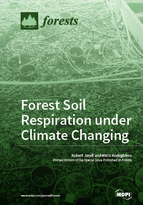Forest Soil Respiration under Climate Changing
A special issue of Forests (ISSN 1999-4907).
Deadline for manuscript submissions: closed (31 January 2017) | Viewed by 65551
Special Issue Editors
Interests: forestry; soil; soil carbon
Special Issues, Collections and Topics in MDPI journals
Special Issue Information
Dear Colleagues,
The respiration of forest soils and the major factors controlling its rate are fairly well understood. The process is of utmost significance because its balance with the fixation of CO2 in the biomass defines whether a particular site is a source or sink of atmospheric CO2. Currently, the measurement of soil respiration in the field requires rather expensive experimental installations. Nevertheless, there are still some caveats in our understanding, such as the separation of autotrophic and heterotrophic soil respiration, the relevance of different groups of soil organisms, the effect of ecosystem disturbances in different types of forests on soil respiration with respect to magnitude and duration, the adaptation of soil respiration to changing site conditions, and the regional prediction of soil respiration, based on proxy data. Technical progress and additional contributions on process understanding will put us in the position of better predictions of the forest soil respiration. We encourage studies from all fields, including experimental studies, monitoring approaches and models, to contribute to this Special Issue in order to promote knowledge and adaptation strategies for the preservation, management, and future development of forest ecosystems.
Dr. Robert Jandl
Guest Editor
Manuscript Submission Information
Manuscripts should be submitted online at www.mdpi.com by registering and logging in to this website. Once you are registered, click here to go to the submission form. Manuscripts can be submitted until the deadline. All submissions that pass pre-check are peer-reviewed. Accepted papers will be published continuously in the journal (as soon as accepted) and will be listed together on the special issue website. Research articles, review articles as well as short communications are invited. For planned papers, a title and short abstract (about 100 words) can be sent to the Editorial Office for announcement on this website.
Submitted manuscripts should not have been published previously, nor be under consideration for publication elsewhere (except conference proceedings papers). All manuscripts are thoroughly refereed through a single-blind peer-review process. A guide for authors and other relevant information for submission of manuscripts is available on the Instructions for Authors page. Forests is an international peer-reviewed open access monthly journal published by MDPI.
Please visit the Instructions for Authors page before submitting a manuscript. The Article Processing Charge (APC) for publication in this open access journal is 2600 CHF (Swiss Francs). Submitted papers should be well formatted and use good English. Authors may use MDPI's English editing service prior to publication or during author revisions.
Keywords
- soil respiration
- autotrophic respiration
- heterotrophic respiration
- disturbance
- modeling






